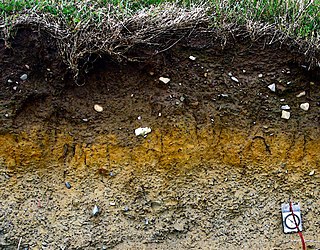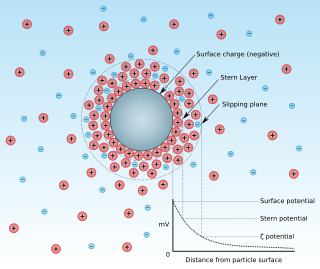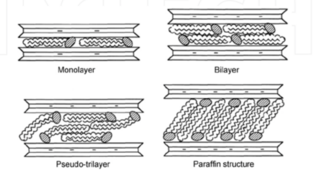Related Research Articles

A colloid is a mixture in which one substance consisting of microscopically dispersed insoluble particles is suspended throughout another substance. Some definitions specify that the particles must be dispersed in a liquid, while others extend the definition to include substances like aerosols and gels. The term colloidal suspension refers unambiguously to the overall mixture. A colloid has a dispersed phase and a continuous phase. The dispersed phase particles have a diameter of approximately 1 nanometre to 1 micrometre.

Soil, also commonly referred to as earth or dirt, is a mixture of organic matter, minerals, gases, liquids, and organisms that together support the life of plants and soil organisms. Some scientific definitions distinguish dirt from soil by restricting the former term specifically to displaced soil.

Water purification is the process of removing undesirable chemicals, biological contaminants, suspended solids, and gases from water. The goal is to produce water that is fit for specific purposes. Most water is purified and disinfected for human consumption, but water purification may also be carried out for a variety of other purposes, including medical, pharmacological, chemical, and industrial applications. The history of water purification includes a wide variety of methods. The methods used include physical processes such as filtration, sedimentation, and distillation; biological processes such as slow sand filters or biologically active carbon; chemical processes such as flocculation and chlorination; and the use of electromagnetic radiation such as ultraviolet light.

Bentonite is an absorbent swelling clay consisting mostly of montmorillonite which can either be Na-montmorillonite or Ca-montmorillonite. Na-montmorillonite has a considerably greater swelling capacity than Ca-montmorillonite.

In chemistry, electrophoresis is the motion of charged dispersed particles or dissolved charged molecules relative to a fluid under the influence of a spatially uniform electric field. As a rule, these are zwitterions. Electrophoresis of positively charged particles or molecules (cations) is sometimes called cataphoresis, while electrophoresis of negatively charged particles or molecules (anions) is sometimes called anaphoresis.

Zeta potential is the electrical potential at the slipping plane. This plane is the interface which separates mobile fluid from fluid that remains attached to the surface.

In colloidal chemistry, flocculation is a process by which colloidal particles come out of suspension to sediment in the form of floc or flake, either spontaneously or due to the addition of a clarifying agent. The action differs from precipitation in that, prior to flocculation, colloids are merely suspended, under the form of a stable dispersion and are not truly dissolved in solution.

A leachate is any liquid that, in the course of passing through matter, extracts soluble or suspended solids, or any other component of the material through which it has passed.
In materials science, the sol–gel process is a method for producing solid materials from small molecules. The method is used for the fabrication of metal oxides, especially the oxides of silicon (Si) and titanium (Ti). The process involves conversion of monomers into a colloidal solution (sol) that acts as the precursor for an integrated network of either discrete particles or network polymers. Typical precursors are metal alkoxides. Sol–gel process is used to produce ceramic nanoparticles.
Hybrid solar cells combine advantages of both organic and inorganic semiconductors. Hybrid photovoltaics have organic materials that consist of conjugated polymers that absorb light as the donor and transport holes. Inorganic materials in hybrid cells are used as the acceptor and electron transporter in the structure. The hybrid photovoltaic devices have a potential for not only low-cost by roll-to-roll processing but also for scalable solar power conversion.

The point of zero charge (pzc) is generally described as the pH at which the net charge of total particle surface (i.e. absorbent's surface) is equal to zero, which concept has been introduced in the studies dealt with colloidal flocculation to explain pH affecting the phenomenon.

Particle agglomeration refers to the formation of assemblages in a suspension and represents a mechanism leading to the functional destabilization of colloidal systems. During this process, particles dispersed in the liquid phase stick to each other, and spontaneously form irregular particle assemblages, flocs, or agglomerates. This phenomenon is also referred to as coagulation or flocculation and such a suspension is also called unstable. Particle agglomeration can be induced by adding salts or other chemicals referred to as coagulant or flocculant.
Soil chemistry is the study of the chemical characteristics of soil. Soil chemistry is affected by mineral composition, organic matter and environmental factors. In the early 1870s a consulting chemist to the Royal Agricultural Society in England, named J. Thomas Way, performed many experiments on how soils exchange ions, and is considered the father of soil chemistry. Other scientists who contributed to this branch of ecology include Edmund Ruffin, and Linus Pauling.
Electroacoustic phenomena arise when ultrasound propagates through a fluid containing ions. The associated particle motion generates electric signals because ions have electric charge. This coupling between ultrasound and electric field is called electroacoustic phenomena. The fluid might be a simple Newtonian liquid, or complex heterogeneous dispersion, emulsion or even a porous body. There are several different electroacoustic effects depending on the nature of the fluid.
Electrokinetic phenomena are a family of several different effects that occur in heterogeneous fluids, or in porous bodies filled with fluid, or in a fast flow over a flat surface. The term heterogeneous here means a fluid containing particles. Particles can be solid, liquid or gas bubbles with sizes on the scale of a micrometer or nanometer. There is a common source of all these effects—the so-called interfacial 'double layer' of charges. Influence of an external force on the diffuse layer generates tangential motion of a fluid with respect to an adjacent charged surface. This force might be electric, pressure gradient, concentration gradient, or gravity. In addition, the moving phase might be either continuous fluid or dispersed phase.
Sedimentation potential occurs when dispersed particles move under the influence of either gravity or centrifugation or electricity in a medium. This motion disrupts the equilibrium symmetry of the particle's double layer. While the particle moves, the ions in the electric double layer lag behind due to the liquid flow. This causes a slight displacement between the surface charge and the electric charge of the diffuse layer. As a result, the moving particle creates a dipole moment. The sum of all of the dipoles generates an electric field which is called sedimentation potential. It can be measured with an open electrical circuit, which is also called sedimentation current.
The peptization of a liquid mixture is the process of converting the mixture into a colloid by shaking it with a suitable electrolyte called a peptizing agent. That is, the insoluble solid particles which have settled out of the mixture are reformed into microscopic particles suspended in the mixture. Peptization is the reverse of flocculation, the aggregation of colloidal particles into precipitate; as such, it is also known as deflocculation.
Clay chemistry is an applied subdiscipline of chemistry which studies the chemical structures, properties and reactions of or involving clays and clay minerals. It is a multidisciplinary field, involving concepts and knowledge from inorganic and structural chemistry, physical chemistry, materials chemistry, analytical chemistry, organic chemistry, mineralogy, geology and others.

Polymer soil stabilization refers to the addition of polymers to improve the physical properties of soils, most often for geotechnical engineering, construction, or agricultural projects. Even at very small concentrations within soils, various polymers have been shown to increase water retention and reduce erosion, increase soil shear strength, and support soil structure. A wide range of polymers have been used to address problems ranging from the prevention of desertification to the reinforcement of roadbeds.

Noam Weisbrod is a Hydrology Professor at the Department of Environmental Hydrology and Microbiology of the Zuckerberg Institute for Water Research (ZIWR), which is part of the Jacob Blaustein Institutes for Desert Research (BIDR) at Ben-Gurion University of the Negev (BGU). Weisbrod served as director of ZIWR from 2015 to 2018. In 2018 he became director of BIDR and was reelected for a second term in summer 2022.
References
- ↑ Frimmel, Fritz H.; Frank von der Kammer; Hans-Curt Flemming (2007). Colloidal transport in porous media (1 ed.). Springer. p. 292. ISBN 978-3-540-71338-8.
- ↑ Alonso, U.; T. Missana; A. Patelli; V. Rigato (2007). "Bentonite colloid diffusion through the host rock of a deep geological repository". Physics and Chemistry of the Earth, Parts A/B/C. 32 (1–7): 469–476. Bibcode:2007PCE....32..469A. doi:10.1016/j.pce.2006.04.021. ISSN 1474-7065.
- ↑ de Jonge, L.W.; C. Kjaergaard; P. Moldrup (2004). "Colloids and colloid-facilitated transport of contaminants in soils: An introduction". Vadose Zone Journal. 3 (2): 321–325. doi:10.2113/3.2.321.
- ↑ Voegelin, A.; Kretzschmar, R. (December 2002). "Stability and mobility of colloids in Opalinus Clay". Technischer Bericht / NTB. Nagra Technical Report 02-14. Institute of Terrestrial Ecology, ETH Zürich: 47. ISSN 1015-2636.
- ↑ "Diffusion of colloids in compacted bentonite". Archived from the original on 2009-03-04. Retrieved 2009-02-12.
- ↑ Wold, Susanna; Trygve Eriksen (2007). "Diffusion of humic colloids in compacted bentonite". Physics and Chemistry of the Earth, Parts A/B/C. 32 (1–7): 477–484. Bibcode:2007PCE....32..477W. doi:10.1016/j.pce.2006.05.002. ISSN 1474-7065.
- ↑ Durce, D.; Salah, S.; Maes, N. (2016). Presence and mobility of colloidal particles. COVRA report N° OPERA-PU-SCK614 (Report). Archived from the original on 2017-04-09. Retrieved 2017-04-08.